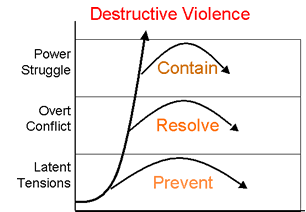Three Opportunities
Three things you can do to take the Third Side in any conflict: Prevent, Resolve, and Contain
Conflict does not come out of nowhere but proceeds from latent tension, develops into overt conflict, erupts into power struggle, and from there crosses the threshold of destructive conflict and violence. As Thirdsiders, our aim is not to suppress conflict altogether but simply to keep the trajectory of escalation below this threshold.
 In a addition to being a perspective, the Third Side is a systemic approach to handling conflict. We have at least three major opportunities to transform conflict from destructive fighting into constructive change.
In a addition to being a perspective, the Third Side is a systemic approach to handling conflict. We have at least three major opportunities to transform conflict from destructive fighting into constructive change.
The first is to prevent destructive conflict from emerging in the first place by addressing latent tensions. The second is to resolve any overt conflicts which do develop. The third is to contain any escalating power struggles that temporarily escape resolution. What is not prevented is resolved; and what is not resolved is contained. The motto of the Third Side is thus: “Contain if necessary, resolve if possible, best of all prevent.”
In difficult conflicts it’s often not enough to use one mode. Many of these conflicts can best be transformed by using all three modes.
1. Prevent
“Confront the difficult while it is still easy; accomplish the great task by a series of small acts.”
-Lao-Tzu
We are learning in our modern societies that prevention is the best cure when it comes to fighting disease. The best way to deal with heart attacks, for example, better than the most sophisticated bypass operations, is to prevent them through good nutrition, regular exercise, and medication. The priority of prevention holds in the arena of destructive conflict too.
Prevention means addressing the root causes of conflict and laying the foundation for the cooperative management of differences. Conflict usually arises in the first place from frustrated needs. Tensions over conflicting needs can easily escalate when people lack the proper skills or attitudes to defuse them. Good relationships, moreover, are key to preventing conflict.
Our challenge is to learn to embed prevention in the fabric of normal life. We can enable others to meet their basic needs, give them the skills to handle disputes, and help them forge relationships across lines of conflict. These constitute the three main preventive roles of the third side: the Provider, the Teacher, and the Bridge-Builder.
2. Resolve
“Jaw jaw is better than war war.”
-Winston Churchill
Prevention is essential but it is not enough. Many conflicts become overt and need to be resolved.
There are at least four different approaches for resolving a dispute. Either one tries to reconcile the conflicting interests of each side through talking, or one takes the issue to a third party who determines the rights of each side, or one decides on the basis of power – by striking, for instance. Even though the interests approach is generally preferable, the rights and power approaches have an important role to play, if only as backups when talking alone does not succeed. A fourth approach exists, parallel to the other three. Since the accumulated distrust and hostility between the parties often proves a huge obstacle to collaborative problem-solving, the fourth approach is to heal the strained relationship.
Thirdsiders can make a critical contribution to each of the four resolution approaches. As Mediators, we can help reconcile the parties’ interests. As Arbiters, we can determine rights. As Equalizers, we can help equalize the power between the parties. And as Healers, we can help repair injured relationships.
3. Contain
“The best general does not fight.”
-Sun Tzu
Many individuals, groups, and nations still believe that force is the only way to resolve serious conflicts. Sometimes prevention and resolution alone may not stop escalation. The challenge for Thirdsiders is to contain the power struggle so that the parties may be brought back to the negotiating table.
Unresolved conflict escalates because no one is paying attention to the conflict or, even if someone is, because no one sets limits on the fighting, or, lastly, because no one intervenes to provide protection. As Thirdsiders, we can learn to contain conflict by playing three successive, increasingly interventionist roles: as Witness, as Referee, and as Peacekeeper.







